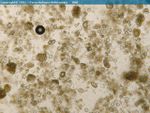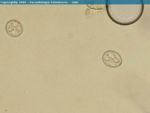Coccidiosis - Cattle
- Many species affect cattle
- Cattle under a year old are usually infected sporadically
- 2-3 week prepatent period
- Eimeria bovis
- Eimeria zuernii
- Endogenous stages in connective tissue of lamina propria of the lower small intestine and in the epithelial cells of the caecum and colon
- More pathogenic than Eimeria bovis
- Causes blood stained dysentery, tenesmus and sloughed mucosa
- Oocysts are spherical and measure 16μm
- Mainly occurs in calves in poor conditions and bought-in calves
- Also occurs in suckler calves turned out in spring
- Eimeria alabamensis associated with diarrhoea in calves after spring turnout
- Passive immunity is sufficient during the neonatal period
- Can be concurrent with cryptosporidium, viral and bacterial agents
Diagnosis
- History, clinical signs, diarrhoea (often with blood) and a decrease in weight gain
- Post-mortem
- High faecal oocyst count
- However, healthy animals can pass millions of oocysts from mixed species infections which have no pathogenic significance
- Animals may die before oocysts are shed
Control
- Improve husbandry
- Improve sanitation
- Increase bedding
- Raise food and water troughs to avoid faecal contamination
- Preventative in-feed medication
- E.g. Decoquinate
- Injectable antiprotozoals may limit oocyst production but animals should still be moved to a clean environment
- E.g. Sulphamethoxypyridazine

